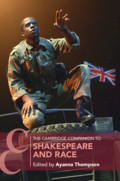
To coincide with the publication of The Cambridge Companion to Shakespeare and Race, we talked to some of the contributors of the volume. We asked them what they hope students and teachers would gain from their chapter, and where they hope the field will go in the future.
Read on for their responses…
Scott Newstok, Rhodes College
Chapter: How to Think Like Ira Aldridge
What we can learn from the first black Shakespearean to achieve international professional renown? From 1825 until 1867, Aldridge toured throughout Europe. Just before his death, he was on the cusp of a return to his native United States. His cosmopolitan life was marked by triumphs as well as persistently racist responses to his roles. My chapter surveys seven of Ira Aldridge’s strategies for succeeding on the nineteenth-century stage: Educate; Emulate; Circulate; Nominate; Innovate; Disseminate; Elaborate. Today, these strategies can still inspire us — students, performers, scholars, artists, teachers, innovators, and researchers alike.
Andrew Hadfield, University of Sussex
Chapter: Race in Shakespeare’s Histories
It has been a privilege to be part of this ground-breaking collection, which aims to make questions of race central to the study of the age of Shakespeare, a subject that has been ignored and submerged in the academy and the theatre for far too long. Shakespeare represents English identity as problematic and unstable in the history plays, the English shown to be a hybrid race struggling to forge a distinct understanding of themselves through their inheritance and their blood. Far from being nostalgic works imagining an enclosed, sceptered Isle, the history plays demonstrate that on the cusp of empire, the fantasy of a pure identity was a dangerous fiction.
Noémie Ndiaye, University of Chicago
Chapter: Shakespeare, Race, and Globalization: Titus Andronicus
This essay will help students and teachers think about the deployment of race in Titus Andronicus as embedded in the developing logic of capitalism-driven globalization. It recovers the spectral presence of the Americas, colonization, globalization, and proto-imperial English aspirations in Shakespeare’s play in order to explain its disquieting and at times self-contradictory treatment of race. Such dynamics, however, are not unique to this play or to Shakespeare: generally, racial formations and racial capitalism in early modern England cannot properly be understood outside of a global framework, which is the framework of Black studies.
Virginia Mason Vaughan and Alden T. Vaughan, Clark University
Chapter: The Tempest and Early Modern Conceptions of Race
We hope readers will see that The Tempest reflects early modern England’s nascent racial thinking, especially in the other characters’ comments about Caliban and in Caliban’s own words and actions, but also in the banter about Claribel’s marriage to an Ethiopian. The play not only denigrates people of color, the basic structure is infused with early modern Europe’s systems of servitude and slavery. If anyone still holds to the old “Shakespeare and Race are anachronistic” school of thought, this volume should shatter any vestiges of it. It’s hard to predict the future, but surely it will include more nuanced analyses of race in early modern literature, including Shakespeare but also in other texts of the period. New sources may come to light, too, that will help to refine today’s perspectives and conclusions.
Dennis Austin Britton, University of New Hampshire
Chapter: Flesh and Blood: Race and Religion in The Merchant of Venice
I hope students and teachers will get a better understanding of how interconnected race and religion were in Shakespeare’s day, and even in our own. We may think of religion as primarily a matter of belief, but Shakespeare’s Merchant of Venice shows us that religious identity is also understood as a semi-biological, inherited racial characteristic. And if this is true, the possibility of converting from one religion to another becomes difficult, if not impossible, to conceive. I think there is still more work to be done to help us understand the connections between race and religion, especially how specific theological systems—for example, Roman Catholicism, Lutheranism, and Calvinism—shape ideas about race.
Patricia Akhimie, Rutgers University
Chapter: Racist Humor and Shakespearean Comedy
I hope this essay will make it much easier for teachers to broach the topic of racist language and caricature in Shakespeare’s comedies, where it abounds. I hope this essay will offer students tools with which to dismantle racist humor wherever they encounter it, in Shakespeare, in literature and popular media, anywhere. I hope the field will continue to explore the connections and continuities between the race thinking of the early modern and our present. I think understanding the ways in which our thinking about racial difference both does, and does not change over long periods of time is an effective means of undermining racism and its impact on our lives.
Urvashi Chakravarty, University of Toronto
Chapter: What Is the History of Actors of Color Performing in Shakespeare in the UK?
My essay addresses the genealogy of actors of colour performing Shakespeare in the UK, turning to an expanded range of archives—not only performative but also popular and legal archives—in order to examine these histories. I hope that teachers and students will continue to excavate and explore the significance and scope of this history, and will reflect on the contingencies of the archives, what they include and exclude, and how and why we work to recover and reconstruct the vital performance history of Shakespearean actors of colour. My hope is that the field will come to recognize that the history of Shakespeare—and Shakespearean performance, its actors and absences, its traces and lacunae—is inextricably bound up with the history of race and race-making.
Melissa E. Sanchez, University of Pennsylvania
Chapter: Was Sexuality Racialized for Shakespeare? Antony and Cleopatra
In my essay, “Was Sexuality Racialized for Shakespeare?,” I argue that Antony and Cleopatra questions 1) a binary vision of racialized sexuality and 2) the colonial and imperial projects that such a binary legitimizes. I seek to draw readers’ attention to a number of racialized sexual types: along with the seemingly whitest of men, Caesar, and the darkest of women, Cleopatra, this play includes the virago Fulvia, the chaste wife Octavia, the eunuch Mardian, and the spectral figure of the “boy” catamite whom Antony, Cleopatra, and Caesar all fear becoming. By noticing how these racialized sexual types converge in Antony and Cleopatra, I hope that students and teachers of Shakespeare can become more attentive to the contradictions and fissures within concepts of self-mastery and self-determination that continue to shape modern racial and imperial hierarchies.

Latest Comments
Have your say!